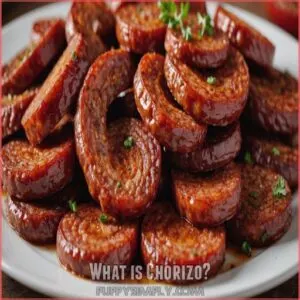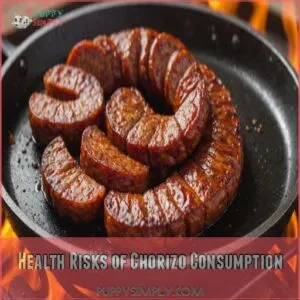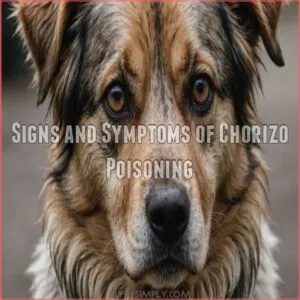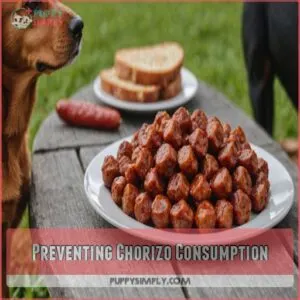This site is supported by our readers. We may earn a commission, at no cost to you, if you purchase through links.
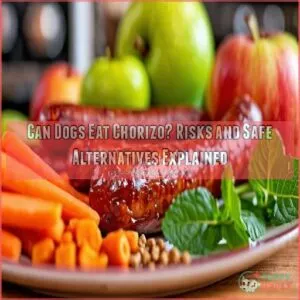 Can dogs eat chorizo? Unfortunately, that deliciously spicy sausage isn’t safe for your furry friend.
Can dogs eat chorizo? Unfortunately, that deliciously spicy sausage isn’t safe for your furry friend.
Chorizo is packed with salt and fat, which can upset your dog’s stomach faster than you can say "fetch!"
Plus, the flavorful spices like paprika and chili are a no-go for canines. Eating chorizo might lead to serious health issues like high blood pressure or worse.
Instead of playing vet roulette, stick to dog-friendly treats that keep tails wagging safely.
So, while chorizo might tempt your pup from your breakfast plate, it’s best to save it for the humans. Want to know about safe alternatives? Keep reading!
Table Of Contents
- Key Takeaways
- What is Chorizo?
- Is Chorizo Safe for Dogs?
- Health Risks of Chorizo Consumption
- Signs and Symptoms of Chorizo Poisoning
- What to Do if Your Dog Eats Chorizo
- Safe Alternatives to Chorizo
- Preventing Chorizo Consumption
- Homemade Chorizo-Inspired Dog Treats
- Seeking Veterinary Advice
- Frequently Asked Questions (FAQs)
- Can you eat chorizo raw?
- Can dogs eat chorizo sausage?
- Is chorizo bad for dogs?
- Can Shih Tzus eat chorizo?
- Can dogs eat soy chorizo?
- Can dogs eat chorizo & potatoes?
- What happens if my dog eats chorizo?
- Is Mexican chorizo safe to eat?
- Can I give my dog soy chorizo?
- Can dogs have cooked chorizo and eggs?
- Can puppies eat chorizo in any amount?
- Are there benefits of chorizo for dogs?
- How often do dogs eat chorizo unknowingly?
- Can dogs build tolerance to chorizo over time?
- Is chorizo harmful to cats as well?
- Conclusion
Key Takeaways
- Don’t let your dog eat chorizo; its spicy ingredients, high salt, and fat content can lead to serious health issues like stomach upset and anemia.
- Garlic, onion powder, and other spices in chorizo are toxic to dogs, making this sausage unsafe and potentially harmful.
- Instead of chorizo, opt for safe treats like cooked chicken, fish, or vegetables to keep your dog healthy and happy.
- Always supervise and train your dog to avoid sneaky snacking on dangerous foods, and consult your vet if any symptoms arise.
What is Chorizo?
You probably know chorizo as a delicious, spicy sausage, but did you know it’s a big no-no for your furry friend?
It’s typically made with pork, sometimes beef or chicken, and packed with seasonings that can be harmful to dogs.
Ingredients and Preparation
Chorizo’s spicy allure might tickle your taste buds, but for dogs, it’s a risky treat.
Typical chorizo ingredients include: 1. Pork blended with garlic powder and onion powder—both toxic to dogs.
- Various spice levels that create potential digestive havoc.
- Different cooking methods, enhancing its flavor yet concealing dangers.
So, protect your furry friend by steering clear of this tempting sausage.
Spanish and Mexican Variations
You’re thinking about your spicy favorites, like chorizo, cherished from Spain to Mexico.
Spanish chorizo, with its garlic and paprika-rich flavor, is often cured and ready-to-eat.
Meanwhile, Mexican chorizo bursts with chili peppers and boldness and requires cooking before enjoying.
Each type showcases unique chorizo types and flavors, depending on the region and cooking methods.
Cultural Significance
Imagine a festival without its star—chorizo.
This flavorful sausage spices up everything from Spanish fiestas to Mexican family gatherings, capturing tradition and history in each link.
Recipes passed down generations highlight its rich, smoky goodness.
While chorizo brightens your table, it’s best to remember, it’s meant for humans, not dogs!
So, enjoy it wisely, savoring cultural heritage with every bite.
Is Chorizo Safe for Dogs?
While your dog might be eyeing that spicy chorizo on your plate, it’s important to know it’s not a safe treat for them.
The ingredients in chorizo can cause digestive issues and more serious health problems due to its toxic ingredients, high-fat content, and excessive salt.
Toxic Ingredients
While pondering if chorizo is a suitable treat for your dog, beware of its toxic ingredients.
These flavors might spice up human dishes, but for dogs, they’re a recipe for trouble.
- Garlic and onion powder: Harmful to blood cells.
- Paprika and chili peppers: Irritate their stomach.
- Salt: Risky for sodium levels.
- Potential anemia triggers: Garlic and onion.
High-Fat Content
Chorizo isn’t just spicy; it’s packed with high-fat content that spells trouble for dogs, particularly due to the risks associated with high levels of spices.
Think of it as a fast track to dog obesity and pancreatitis risk.
That pork fat in chorizo, a type of processed meat, isn’t doing your pup’s waistline or pancreas any favors.
Opt
Salt and Sodium
That high-fat content isn’t the only worry with chorizo.
Now, let’s talk salt. Seriously, the salt content is a big deal! Too much sodium is no joke; it can lead to some nasty stuff.
Here’s what you need to know: If you’re looking for dog food that’s lower in sodium, check out these options, which can be a good choice for dogs with dietary restrictions.
High sodium diets are dangerous. Sodium poisoning is a real threat. Your dog’s body can’t handle excessive salt. Look for dog food with lower sodium.
Keep chorizo far away from your furry friend’s bowl. It’s simply not worth the risk.
Health Risks of Chorizo Consumption
When your dog sneaks a bite of chorizo, it can lead to more than just a disappointed pup.
This spicy treat poses serious risks like gastrointestinal upset and anemia, making it a no-go for your furry friend.
Gastrointestinal Upset
When thinking about dog food sensitivities, chorizo isn’t your pup’s best friend.
Besides its tempting aroma, this spicy treat can lead to gastrointestinal upset.
Spices and high-fat content cause stomach issues, resulting in diarrhea and digestive irritation.
It’s like a parade in your pup’s belly, but not the fun kind.
For stomach problems, consider bland alternatives to keep your furry friend healthy.
Heart Disease and High Blood Pressure
While acknowledging tummy troubles, let’s talk dog heart health.
That spicy chorizo packed with pork meat and sodium isn’t just diet sabotage—it’s a heart risk.
High salt nudges blood pressure upward, a recipe for heart disease in dogs.
For dogs with heart health concerns, consider exploring dog blood pressure food options.
Switching to a salt-free diet
Parasitic Infection
You might be tempted to share chorizo with your furry friend, but raw meat in this sausage can carry worms, leading to a nasty parasitic infection.
If left unchecked, this can cause chronic diarrhea, learn more about the causes and treatment of my dog has diarrhea.
Symptoms like vomiting and diarrhea could pop up, making everyone miserable.
Prevent issues by keeping chorizo out of paw.
Anemia and Blood Cell Damage
After considering parasite woes, anemia in dogs also raises eyebrows.
Chorizo’s garlic and onions can severely harm your dog’s blood cell health.
These ingredients trigger Heinz body anemia, leading to red blood cell destruction.
Here’s a snapshot of concerns:
- Signs include weakness and pale gums
- Risk of anemia from just a small bite
- Regular vet checks are essential
- Better safe than sorry
- Opt for safe treats
Signs and Symptoms of Chorizo Poisoning
If your dog devours chorizo, watch out for telltale signs like vomiting, diarrhea, or even a sudden lack of energy.
A skin rash or itchy red spots might also pop up, so keep an eye out for any odd behaviors—you know, those unusual antics that aren’t just about fetching tennis balls.
Vomiting and Diarrhea
Uh oh, stomach trouble?
If your pup’s been snacking on chorizo, vomiting and diarrhea are common signs of gastrointestinal upset.
For severe cases, consider exploring Dog Vomiting Remedy options.
These symptoms, along with stomach problems, point to chorizo’s spicy ingredients and high fat content.
Monitor your dog closely; if it’s severe,
Skin Irritation and Allergic Reactions
Chorizo can give your furry friend more than just a tummy ache.
Skin irritation and allergic reactions are also on the menu, thanks to paprika and garlic powder.
If your dog experiences itchy skin, consider looking into dog food for itchy skin.
Watch for:
- Itchy spots resembling a map to hidden treats.
- Red, inflamed skin that
Lethargy and Lack of Appetite
If you’ve noticed your pup scratching after chomping down on chorizo, there’s more to watch for.
Lethargy and lack of appetite might follow, making your dog seem like they’ve lost their get-up-and-go.
This isn’t their usual nap time behavior—it’s a sign something’s amiss.
A vet visit is in order to explore treatment options and guarantee their dog health.
What to Do if Your Dog Eats Chorizo
If your dog sneaks a bite of chorizo, don’t panic just yet; keep an eye out for any signs of stomach upset.
It’s always a good idea to have your vet’s contact handy in case your furry friend starts acting unusual.
Monitoring for Signs of Illness
Seeing your dog gobble up chorizo is nerve-wracking.
Be on the lookout for any dog behavior changes or signs of digestive issues.
Keep an eye out for vomiting, lethargy, and diarrhea.
Here’s what to watch for:
- Dog behavior changes, like restlessness.
- Digestive issues, leading to tummy trouble.
- Lethargy, showing unusual fatigue.
- Vomiting or diarrhea, indicating gastrointestinal upset.
Soothing Your Dog’s Stomach
After keeping an eye out for illness signs, try soothing your dog’s stomach.
Offer bland foods like white rice and boiled chicken.
Steer clear of rich foods and consider probiotics for dogs, which can help balance their gut.
Home remedies work wonders sometimes, but remember, you know your furry friend best and when they just need a bit of extra love.
Consulting Your Veterinarian
Feeling uneasy about your pup’s chorizo mishap? It’s time to consult your veterinarian. They’ve got the expertise to assess any digestive issues from high sodium levels, which can be a concern with processed meats like chorizo can dogs eat lunch meat, and address dog health risks, especially from toxic ingredients.
While monitoring symptoms is helpful, seeking professional veterinary advice guarantees pet safety.
After all, it’s better to be safe than sorry when it comes to emergency procedures for your furry friend’s health.
Safe Alternatives to Chorizo
Worried about giving your pup tasty treats without the chorizo?
Don’t fret, there are plenty of safe and delicious alternatives like cooked chicken, fish, or even some well-chosen veggies that’ll keep your furry friend happy and healthy.
Cooked Chicken and Turkey Options
Wondering what to feed your dog instead of chorizo?
Cooked chicken and turkey are excellent, safe alternatives.
They’re packed with protein and free from the toxic ingredients in chorizo, keeping your furry friend healthy.
Use simple cooking methods, skipping the seasonings.
Remember, dogs have unique nutritional needs and certain human foods, like hot dogs with sodium nitrate, can be toxic to them, so portion control is key—a small piece of chicken or turkey works wonders for your dog’s nutrition and health.
Fish and Vegetable Alternatives
Chicken and turkey are great, but let’s spice things up without the chorizo!
Fish and veggies can work wonders for your dog’s diet.
Opt for fish-based dog treats or whip up some homemade dog food with safe fish types.
Veggie dog treats are also a hit.
- Nutritious and safe for Fido
- Easy on sensitive tummies
- Bursting with natural flavor
High-Quality Dog Food Brands
A plethora of high-quality dog food brands offer your pup safe alternatives to chorizo.
Prioritize ingredient transparency and brand reputation to make sure your dog’s dietary needs are met without toxic ingredients.
Check customer reviews and do a price comparison to find the best fit.
Swapping out chorizo for well-reviewed dog food might feel like the healthier treat your dog deserves!
Preventing Chorizo Consumption
You can keep your dog safe from chorizo by placing it well out of reach and watching your pet closely.
Training your dog to leave food alone is also a great way to prevent any accidental snacking disasters.
Keeping Food Out of Reach
After exploring safe snacks, it’s time to keep chorizo out of your dog’s reach.
Dog-proofing kitchens is easier than you think.
Try these tips:
- Store chorizo in child-proof containers, thwarting nosy pups.
- Use secure storage solutions like high shelves.
- Prioritize countertop safety by ensuring tempting treats aren’t within paw’s reach.
Follow safe meat handling practices, such as keeping raw dog food in the freezer for safety and preventing cross-contamination, to protect your dog’s health!
Supervising Your Dog’s Behavior
Putting snacks safely out of paw’s reach is only half the battle.
Keep a keen eye on your curious canine during meal prep or family picnics—an ounce of prevention’s worth a pound of kibble!
Use supervision tips to steer your furry friend clear of chorizo and its toxic ingredients.
Remember, attentive guidance guarantees your dog’s health and safety.
Training Your Dog to Leave Food Alone
So, you’ve mastered keeping chorizo out of sight, but your dog’s still a sneaky snacker?
It’s time for some serious "leave it" training!
Consistency is key; use positive reinforcement and distraction techniques.
Reward good behavior, not just obedience.
It’s a marathon, not a sprint!
- Start with simple "leave it" commands.
- Use high-value treats as rewards.
- Practice in various locations.
- Gradually increase the difficulty.
- Address any underlying food guarding issues.
Homemade Chorizo-Inspired Dog Treats
Why not whip up some delicious chorizo-inspired dog treats that are safe for your furry friend?
With a few simple ingredients and substitutions, you can create tasty snacks without the risky spices.
Ingredients and Substitutions
Imagine this: your dog eyeing your chorizo with puppy-dog eyes.
Instead, try a homemade treat with healthy ingredients like lean turkey, a sprinkle of dog-safe spices, and chorizo substitutes, keeping in mind the risks of chorizo for dogs can dogs eat chorizo and egg.
Avoid toxic ingredients like garlic or onion powder.
Spice alternatives can include turmeric or parsley for a burst of
Instructions and Preparation
Rolling up your sleeves and whipping up homemade chorizo-inspired treats for your dog can be a fun kitchen project!
Here’s how to create them with flair:
- Mix ground pork with safe spices—no onions or garlic.
- Shape into small sausage forms.
- Bake until firm at 350°F.
- Cool and let your pup enjoy!
Storage and Safety Tips
Your homemade treats are ready, but how do you store them safely?
Place them in an airtight container and store in the fridge, where they’ll last about a week.
For longer storage, pop them in the freezer—just remember thawing time!
Dispose of leftovers past their prime.
Proper handling prevents any toxic ingredients from sneaking into your dog’s snacks, ensuring their health.
Seeking Veterinary Advice
If your dog gets a taste of chorizo, it’s a good idea to check in with your veterinarian, as spicy snacks can lead to health issues.
Don’t wait until your pup is howling in discomfort; early advice can help prevent complications.
Risks and Consequences of Consumption
Numerous chorizo dangers could put your furry friend’s health at risk.
Ingredients harmful to dogs, like garlic and onion, can cause food poisoning and digestive issues.
These toxic elements may lead to anemia, raising long-term effects concern.
Always keep an eye on your dog’s diet and consult veterinary care to guarantee their well-being and safety.
Emergency Procedures and Treatment
A chorizo-eating emergency? Don’t panic! Here’s what to do:
- Note any symptoms like vomiting or abdominal pain.
- Contact your veterinarian immediately; they’re your best bet for treatment options.
- Follow their advice closely; speedy action is key for your pup’s health. Remember, a vet visit is always better than a guess!
Preventative Measures and Training
Preventing chorizo mishaps begins with a dog-proof kitchen and training your furry friend to resist temptation.
Command your dog with "leave it" and reward successes, making food safety fun.
If you’re unsure about feeding your dog spicy sausage like chorizo, consider the risks of unhealthy additives like sodium nitrate in hot dogs, which can be toxic to dogs. Consult your vet for advice on toxic ingredients and safe treat alternatives.
Keep your dog’s diet and health top of mind.
Proactive steps pay off!
| Command | Purpose | Reward |
|---|---|---|
| "Leave it" | Avoiding toxic food | Treat alternatives |
| "Stay" | Ensuring food safety | Positive reinforcement |
| "Drop it" | Discouraging bad habits | Praise |
Frequently Asked Questions (FAQs)
Can you eat chorizo raw?
Eating raw chorizo isn’t recommended.
Many types contain pork, which needs cooking to avoid foodborne illnesses.
Besides, it’s more flavorful when cooked.
So, toss it on a skillet and let those spices sing!
Can dogs eat chorizo sausage?
Chorizo, crammed with spices, salt, and fat, isn’t suitable for pups.
Feeding it can cause tummy troubles and even health hazards.
Stick to plain meat or treats, skipping the spicy sausage for your furry friend’s safety.
Is chorizo bad for dogs?
Your furry friend shouldn’t have chorizo—it’s spicy, salty, and loaded with harmful ingredients like garlic and onion powders.
These can upset your dog’s tummy and possibly lead to serious health issues, so it’s best avoided!
Can Shih Tzus eat chorizo?
Imagine a tiny knight, your Shih Tzu, facing a fiery dragon—chorizo!
No, it’s not a good match.
That spicy sausage is packed with things that can make your pup sick.
Stick to safer treats!
Can dogs eat soy chorizo?
Although soy chorizo skips meat, it’s still not dog-friendly.
Its spices and flavors can upset your dog’s tummy, leading to digestive issues.
Stick to safe treats like plain chicken or veggies to keep tails wagging.
Can dogs eat chorizo & potatoes?
Dogs shouldn’t eat chorizo and potatoes.
The spicy sausage can upset their stomachs, while high salt and spice levels are harmful.
Toss a plain potato instead; it’s a safer option, and your furry friend will thank you!
What happens if my dog eats chorizo?
If your dog gobbled up chorizo, watch for tummy troubles like diarrhea or vomiting.
Those spicy sausages are a no-go for pups due to harmful ingredients.
Contact your vet if your furry friend shows any signs of distress.
Is Mexican chorizo safe to eat?
Mexican chorizo is safe for you to eat as long as it’s properly cooked.
It’s flavorful, spicy, and made from pork, but don’t go hog-wild!
Its high fat and spice levels mightn’t agree with everyone.
Can I give my dog soy chorizo?
Feeding your dog soy chorizo might seem like trying to fit a square peg into a round hole.
While it doesn’t contain meat, its spices and additives can still upset your dog’s stomach.
Stick to dog-safe treats instead.
Can dogs have cooked chorizo and eggs?
Dogs shouldn’t have cooked chorizo and eggs.
Chorizo’s spices, fat, and salt can harm dogs, causing stomach upset or even anemia.
Stick with plain, unseasoned eggs for your furry friend’s breakfast to keep tails wagging safely.
Can puppies eat chorizo in any amount?
Nope, absolutely not! Puppies are extra sensitive; chorizo’s harmful ingredients can seriously hurt them. Keep chorizo far away from your furry friend’s bowl. Safer treats abound!
Are there benefits of chorizo for dogs?
Chorizo might tickle your taste buds, but it’s a no-go for Fido.
While it’s protein-packed, its high fat, salt, and harmful spices like garlic outweigh any benefits, making it a risky choice for dogs.
How often do dogs eat chorizo unknowingly?
Ironically, your furry friend often stumbles upon chorizo when you’re not looking, thanks to dropped scraps and open kitchen counters.
It’s important to keep an eye on your food to prevent them from sneaking this spicy treat.
Can dogs build tolerance to chorizo over time?
Dogs can’t build tolerance to chorizo.
It’s packed with harmful ingredients that are toxic, like garlic and onion.
Regularly feeding dogs chorizo risks their health, as it shares similarities with hot dogs, which are known to contain high amounts of sodium, such as harmful ingredients found. Regularly feeding dogs chorizo risks their health.
So, it’s best to keep this spicy treat out of their reach!
Is chorizo harmful to cats as well?
About 10% of cats have sensitive stomachs, so beware giving them chorizo.
Its spicy mix and high-fat content can cause digestive issues, vomiting, or diarrhea.
Stick to cat-friendly treats to keep your feline healthy and purring.
Conclusion
Regarding dogs and chorizo, better safe than sorry.
Despite the tempting smell, this spicy treat isn’t fit for furry consumption.
With high salt, fat, and spices, the risks outweigh any potential taste reward.
Stick to safer options like chicken or fish to keep your pup’s tail wagging without the stomach upset.
Keep those savory treats out of reach, train your dog to avoid unwanted snacks, and always consult a vet if you’re in doubt.
- https://www.petpoisonhelpline.com/pet-tips/sodium-toxicity-symptoms-in-pets/
- https://pets.webmd.com/dogs/ss/slideshow-foods-your-dog-should-never-eat
- https://www.akcpetinsurance.com/blog/cooking-with-your-dog
- https://pangovet.com/?utm_source=dogster&utm_medium=article&utm_campaign=dog_eat_drink
- https://www.vetinfo.com/trichinosis-in-dogs.html

